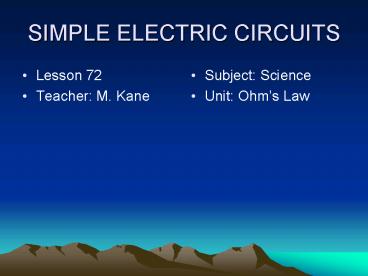SIMPLE ELECTRIC CIRCUITS - PowerPoint PPT Presentation
1 / 15
Title:
SIMPLE ELECTRIC CIRCUITS
Description:
SIMPLE ELECTRIC CIRCUITS. Lesson 72. Teacher: M. Kane. Subject: ... of a light bulb, conductors, insulators, single circuit diagrams, switches, and solutions. ... – PowerPoint PPT presentation
Number of Views:4929
Avg rating:3.0/5.0
Title: SIMPLE ELECTRIC CIRCUITS
1
SIMPLE ELECTRIC CIRCUITS
- Lesson 72
- Teacher M. Kane
- Subject Science
- Unit Ohms Law
2
STANDARD ADDRESSED
- Pennsylvania 3-4-10 B,C
- Physical Science, Physics, and
- Chemistry
3
ASSESSMENT TECHNIQUES
- Assessment/Evaluation
- 1. Students successfully navigate through the
different types of solutions. - 2. Students can explain how electricity works.
- 3. Students display in a poster the electrical
process. - 4. Students demonstrate their understanding of
electrical circuits by successfully constructing
and wiring a cardboard house of their own design
4
ENDURING UNDERSTANDING
- 1. Perform experiments with more complex circuits
under adult supervision. - 2. Visit an electrical power plant and share the
experience with classmates. - 3. Write articles summarizing what has been
learned. - 4. Create pictures or diagrams of circuits using
technological tools. Create a class slide show. - 5. Encourage further reading about unanswered
questions.
5
IMPORTANT KNOWLEDGE
- OHMS LAW
6
OBJECTIFS
- Electric Circuits Children will investigate
electricity and circuits. They will explore
brightness of a light bulb, conductors,
insulators, single circuit diagrams, switches,
and solutions. The unit culminates with students
constructing and wiring a cardboard house of
their own design. - Safety Students will explain safety rules
regarding the use of electricity and chemical
solutions in their everyday lives. - Media Students will become more familiar with
the World Wide Web as a tool for research.
7
METHODS
- GROUP OF 3 STUDENTS
- PREPARATION
- LAB ACTIVITY
- LAB REPORT
8
MATERIALS
- Electric wires
- Lamps
- Switch
- Different liquids (water, acid, juices, coffee,
soda, baking soda) - Stands
- 9 Volts batteries or DC source
9
45 mn ASSIGNMENT
- Cooperative Group Work of Three.
- Discussion and Decisions.
- Data collection
- Analysis
- Synthesis
- Extrapolation
- Conclusion
- Presentation
10
PROCEDURE
- Nature of Electricity
- What is it?
- Historic Misconception (Ben Franklin)
- Symbols
- Model of water flow in a river
11
PROCEDURE
- Major Modification
- Instead of using a resistance in the circuit make
it more meaningful by inserting a lamp (visual
indicator) and a liquid (like water) naturally
available in the real world!
12
PROCEDURE
- Constructing a circuit with a DC source, a
switch, and a lamp in series with a solution
13
PROCEDURE
- Constructing a circuit with a DC source, a
switch, and a lamp in series with a solution - Visualization (qualitative) brightness of lamps
14
PROCEDURE
- Constructing a circuit with a DC source, a
switch, and a lamp in series with a solution - Visualization (qualitative) brightness of lamps
- Closing Circuits with water main pipeline
15
RESOURCES
- Philadelphia School District Science 9th Grade
Core Curriculum. - Montgomery County Public School Instructional
Technology Support Team.

